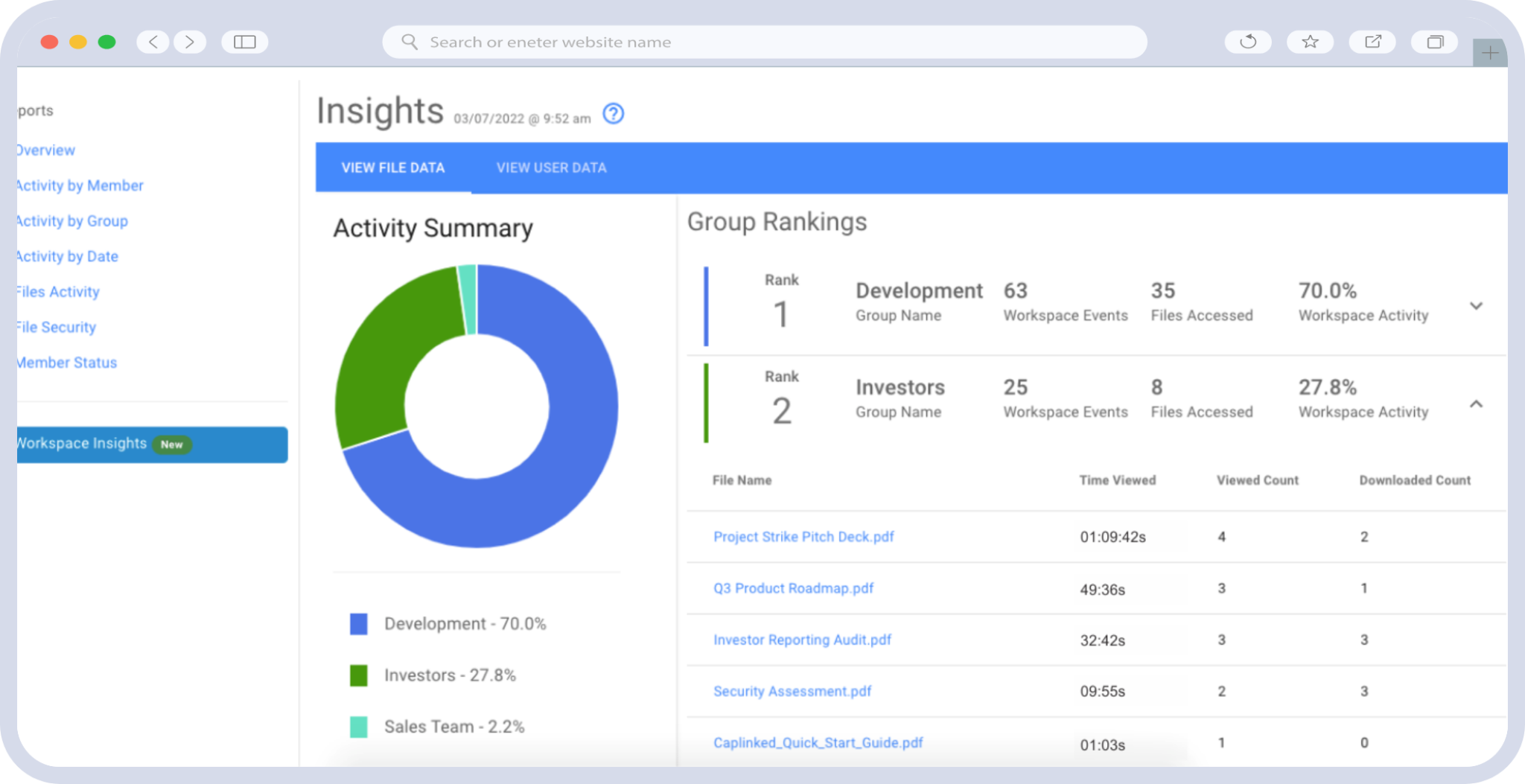The VDR Market Has Entered Its Second Act
Virtual Data Rooms were once the quiet backbone of M&A and capital markets — simple file vaults built for uploading spreadsheets and red-lined contracts. In 2025, they’ve become something very different: a compliance-anchored command center where governance, AI-driven insight, and speed intersect. Dealmakers now expect more than storage. They expect assurance: encryption, auditability, and automation that can withstand regulator or investor scrutiny.
Three converging forces explain why 2025 marks the turning point:
- Compliance has become the product, not a feature.
- AI is transforming diligence and documentation.
- Deal velocity now depends on audit-ready collaboration.
Together, these factors define the modern VDR — a platform that no longer hides in the background of a transaction but actively protects its value.
Compliance Becomes the Core Product
Regulatory Pressure Is the New Deal Risk
The alphabet soup of 2025 regulations — SEC cyber disclosure rules, DORA in Europe, NIS2, and AI-oversight proposals — has elevated compliance from an internal checklist to an external proof point. Every step of diligence — from uploading CUI files to sharing risk reports — must now be verifiable. Failure to document access or control retention can result in enforcement actions or deal delays.
Consequently, enterprises and banks are migrating from basic file-sharing tools to FedRAMP-aligned VDRs capable of showing exactly who viewed what, when, and why. A modern VDR isn’t a repository; it’s an evidence engine.
From Storage to Legal Defense
Audit trails once viewed as administrative bloat have become litigation armor. When regulators request documentation, a CapLinked-style VDR can deliver immutable activity logs showing that policies were followed and sensitive data stayed encrypted.
Examples include:
- A fund proving its AI-governance documents were reviewed by compliance officers pre-deal.
- A corporate acquirer demonstrating that cybersecurity risk was evaluated before sign-off.
- A board retrieving a full trail of diligence actions during a post-merger audit.
In short, modern VDRs translate governance policies into digital evidence — a core requirement for regulated transactions.
The AI Layer Is Reshaping Due Diligence
AI as Analyst, Not Advisor
Artificial Intelligence has entered the diligence workflow, not as a decision-maker but as an accelerator.
Today’s VDRs integrate directly with AI models that:
- Auto-tag and classify unstructured files.
- Identify anomalies in financial records or contracts.
- Summarize document sets for executive review.
This doesn’t replace human judgment — it amplifies it. Analysts can surface red flags in minutes that previously took weeks.
Trustworthy Data as the AI Fuel
AI only functions when fed compliant, structured data. Regulators now require explainability: firms must prove how an algorithm arrived at its output.
That means every file used for training or analysis must reside in a secure, audited VDR environment.
A VDR lacking encryption integrity or metadata structure is essentially off-limits for AI integration. Platforms like CapLinked bridge that gap by providing API-level access to governed data — so machine-learning tools can operate within clear audit boundaries.
AI + Compliance: A New Skill Set
The best deal teams of 2025 aren’t just financial analysts — they’re data stewards.
They understand how model inputs affect valuation and how to document that process.
A compliant VDR makes this possible by preserving metadata, model versions, and disclosure files alongside traditional deal documents.
The result is a future-proof record that meets both SEC and AI oversight expectations.
Deal Velocity Is the New Differentiator
Speed Now Signals Readiness
The days of multi-month diligence cycles are gone. Buyers expect immediate access to clean, indexed, searchable data. A target that can’t provide it risks valuation cuts or deal fatigue. VDRs that streamline permissions, automate notifications, and support integrated Q&A threads directly affect time-to-close.
Workflow Is the New ROI Metric
Modern VDRs serve as the single pane of glass for collaboration. Every stakeholder — legal, financial, cybersecurity, and board — operates in one controlled environment.
Features like:
- Real-time activity feeds,
- Version tracking for redlined files, and
- Secure comment threads
The efficiency gains are quantifiable: deals close faster, legal review shrinks, and compliance responses require less manual reconciliation.
Data Velocity Demands Security
Speed without security is the fastest route to a breach. That’s why the new generation of VDRs aligns with FedRAMP and SOC 2 standards — so data movement never outpaces its controls. CapLinked’s architecture leverages AWS GovCloud and other high-compliance frameworks to deliver both acceleration and assurance.
The Market Shift Away from Legacy VDRs
Legacy VDR vendors grew up in a different era: static data exchange, per-page billing, limited API access. Those models collapse under today’s compliance-driven workflows.
By contrast, modern VDRs like CapLinked offer:
- Flat, transparent pricing that aligns with SaaS economics.
- Role-based permissions that scale with deal size.
- FedRAMP-aligned security trusted by government and enterprise clients.
- API and SSO integrations that fit modern tech stacks.
This isn’t a cosmetic upgrade — it’s a new infrastructure paradigm built for regulatory proof and AI collaboration.
The Future Outlook: The AI-Ready Compliance Stack
From File Vault to Ecosystem Node
By late 2025, the VDR will function less like a portal and more like a compliance microservice.
APIs will connect directly to governance tools, risk dashboards, and even large-language models designed to summarize and cross-reference deal data. The VDR becomes an intelligent layer inside a broader AI-ready compliance stack, where data flows securely from source to model to audit without leaving its governed zone.
Cyber and AI Convergence
As cyber and AI regulation intertwine, platforms will need to demonstrate both technical security and ethical data stewardship. This will push the VDR to support automated risk classification and link those labels to policy templates within the platform.
In practice:
- Every document stored in the VDR will carry its own metadata signature.
- When exported for regulators or investors, the audit package will include traceability for both content and model interaction.
Enterprise and Government Convergence
The lines between enterprise and public sector requirements are blurring.
FedRAMP High, DoD SRG, and CJIS controls are setting the bar for private-sector security.
CapLinked’s work in these frameworks — especially its alignment with AWS GovCloud — positions it to serve both worlds as the standards unify. The next generation of secure deal rooms will look more like GovCloud-compliant collaboration systems than file repositories.
Measuring Trust as a Market Metric
Trust is becoming quantifiable. Investors and acquirers increasingly apply security and compliance scores as valuation factors. A VDR that documents controls and audit responses in real time adds measurable enterprise value. In this sense, compliance is not a cost center — it’s a revenue defense mechanism. Transactions executed through secure, auditable systems close faster, sustain fewer regulatory headaches, and retain higher trust premiums.
Conclusion: The Modern VDR as Strategic Infrastructure
2025 is not simply the year the VDR evolved; it’s the year it became mission-critical. Compliance, AI, and speed are no longer separate objectives — they’re integrated realities. The VDR is where they intersect. Enterprises that treat their VDR as a strategic infrastructure layer — not just a deal tool — will own the next decade of digital transactions. And CapLinked stands ready to power that shift — delivering the security and compliance that define the modern data room era.




